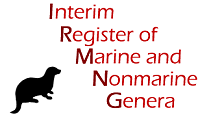
| Intro | | Search taxa | | Taxon tree | | Search literature | | Taxon match | | Homonyms | | Statistics | | Webservice | | Manual | | FAQ | | LifeWatch | | Download | | Log in |
IRMNG taxon detailsKutchiathyrites R.K. Kar, 1979 †
Dictyostroma R. Kar, B.D. Mandaokar & R.K. Kar, 2009 † · unaccepted > junior subjective synonym
Dictyostromata R. Kar, B.D. Mandaokar & R.K. Kar, 2009 † · unaccepted > junior subjective synonym (synonym, also original incorrect...)
synonym, also original incorrect spelling
fossil only
Not documented
Taxonomic remark Fossil fungal conidia containing spores; alternatively, could be treated as fossil fungus. From Saxena et al., 2021:...
Taxonomic remark Fossil fungal conidia containing spores; alternatively, could be treated as fossil fungus. From Saxena et al., 2021: Kalgutkar & Jansonius (2000) opined that Kutchiathyrites is not a microthyriaceous fructification, as stated by Kar (1979), but a multicellular spore/conidium showing a clear attachment area, scar or pore. Kutchiathyrites eccentricus, as described by Kar (1979), demonstrates a close similarity to the conidia of the hyphomycetous fungus Mycoenterolobium platysporum Goos 1970. This similarity was also pointed out by Jain & Kar (1979), who referred to Kendrick & Carmichael (1973), where such eccentric structures are shown as conidia of the hyphomycetous Mycoenterolobium platysporum. [details]
IRMNG (2022). Kutchiathyrites R.K. Kar, 1979 †. Accessed at: https://irmng.org/aphia.php?p=taxdetails&id=1079789 on 2024-12-10
Date action by
basis of record
Index Fungorum (May 2009 version). , available online at http://www.indexfungorum.org/
note: as fossil fungus [details] current name source Saxena, R. K.; Wijayawardene, N. N.; Dai, D. Q.; Hyde, K. D.; Kirk, P. M. (2021). Diversity in fossil fungal spores. <em>Mycosphere.</em> 12(1): 670-874., available online at https://doi.org/10.5943/mycosphere/12/1/8 [details] habitat flag source as per family [details] original description (of Dictyostromata R. Kar, B.D. Mandaokar & R.K. Kar, 2009 †) Kar, R.; Mandaokar, B.; Kar, R. (2010). Fungal taxa from the Miocene sediments of Mizoram, northeast India. <em>Review of Palaeobotany and Palynology.</em> 158(3-4): 240-249., available online at https://doi.org/10.1016/j.revpalbo.2009.09.004 [details] Unreviewed
Descriptive info Ascostromata; Oligocene; Sarangwara, Kutch, India. (Index Nominum Genericorum) [details]Taxonomic remark Fossil fungal conidia containing spores; alternatively, could be treated as fossil fungus. From Saxena et al., 2021: Kalgutkar & Jansonius (2000) opined that Kutchiathyrites is not a microthyriaceous fructification, as stated by Kar (1979), but a multicellular spore/conidium showing a clear attachment area, scar or pore. Kutchiathyrites eccentricus, as described by Kar (1979), demonstrates a close similarity to the conidia of the hyphomycetous fungus Mycoenterolobium platysporum Goos 1970. This similarity was also pointed out by Jain & Kar (1979), who referred to Kendrick & Carmichael (1973), where such eccentric structures are shown as conidia of the hyphomycetous Mycoenterolobium platysporum. [details] |